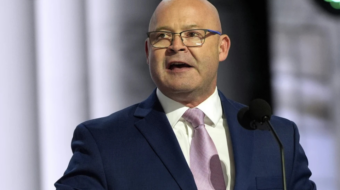
ATLANTA (AP) — The NCAA just doesn’t get it.
Under pressure from all sides — legislators, advocates, athletes, pretty much anyone who can spot an injustice when they see it — the group that governs college athletics revealed a fierce determination to keep an iron grip on the two things it cares about most.
Money and power.
A much-ballyhooed announcement Tuesday, supposedly the first significant step toward coming up with a way to fairly compensate those who bring in the Benjamins, was really nothing more than a blatant attempt to kick the pay-for-play can farther down the road.
The NCAA essentially wants to give its players a chance to set up some inconsequential side hustles that might generate just enough money to keep everyone at bay, all while ensuring that nothing interferes with those billions of dollars that its member schools rake in because of those highly talented athletes.
“One of our principles is not to move to a model where we turn athletes into employees,” Ohio State athletic director Gene Smith said. “Whatever we come up with will not be something where we actually pay players. That’s just not going to happen for us. We believe in the collegiate model, not the professional model.”
It’s easy to see why.
Those in charge are perfectly content with a labor system that essentially allows them to set the maximum wage at zero. Sure, the athletes are getting something of value for holding down their full-time jobs — tuition, room and room, plus a small stipend — but that is a pittance when compared to the revenue that schools such as Georgia and Texas and Ohio State are generating with their athletic programs.
Take Georgia, which has committed some $174 million to upgrading and building facilities just since Kirby Smart took over as football coach in 2016, on top of spending more on recruiting than any other program, not to mention doling out some $13 million in annual pay to Smart and his coaching staff.
The Bulldogs will tell you it’s just the cost of doing business in the cutthroat Southeastern Conference. They’ll point to South Carolina and Florida recently completing $50 million facilities, or LSU spending $28 million on a renovation of its football locker room.
To add some perspective, if LSU doled out $25,000 a year to 100 players, it would take more than 11 years to spend $28 million.
“If only there was enough money …” ESPN analyst and frequent NCAA critic Jay Bilas wrote sarcastically while retweeting a video showing the elaborate facilities in Baton Rouge, which look like something out of a Star Wars movie.
Under a plan unanimously approved by the NCAA Board of Governors during its meeting at Emory University in Atlanta, college athletes would be allowed to cash in on “their name, image and likeness” — a concept the governing body has fought against for years. But no one is quite sure what that means, so each of the NCAA’s three divisions were ordered to come up with rules that would be in place no later than January 2021.
“An athlete would have the ability to monetize their name or their image in commercial ways that are apart from playing,” said Big East Commissioner Val Ackerman, who led the NCAA”s working group along with Smith. “Just as an example, if I started my own business while I was a student and I wanted to use my name to promote my business — I have a type of service I offer — or I write a book, or I compose a song and I want to monetize that using my name or image to promote it, that right now is not permitted under NCAA rules. Under this modernized model, those NIL (name/image/likeness) rights would come to the student-athlete.”
To some, this was a significant concession by an organization that has fought to keep the labor force totally under its heel, but it came only in the face of withering criticism and a threatened onslaught of state and federal laws allowing college athletes to be compensated for their work. California already approved a law that would allow college athletes in its state to hire agents and make money from endorsements, though it won’t go into effect until 2023. Other states are threatening to follow suit, with laws that would hit the books even sooner.
“This working group wouldn’t even be together if it weren’t for California and other states, or Mark Walker (a Republican congressman from North Carolina) filing federal legislation,” said Dave Ridpath, an associate professor of sports business at Ohio University who heads up the Drake Group, which advocates for student-athletes. “I think Congress and other state legislatures will wait and see what this evolves into. If it’s something still not fair or frees up the athlete like a regular student, then you might see more states or at the federal level.
“There are going to be a lot of people pushing.”
And pushing back.
U.S. Sen. Richard Burr, Republican from North Carolina, stepped in out of nowhere to defend the indefensible.
He tweeted Tuesday that “if college athletes are going to make money off their likenesses while in school, their scholarships should be treated like income. I’ll be introducing legislation that subjects scholarships given to athletes who choose to ‘cash in’ to income taxes.”
We already know the NCAA won’t give in easily.
The group is essentially sticking its pinkie in a giant hole in the dam — and hoping that it somehow holds off the flood.
“This is another attempt by the NCAA at stalling on this issue,” said Ramogi Huma, executive director of the National College Players Association.
Bilas is equally skeptical.
As he tweeted not long after the NCAA issued its press release: “From the NCAA Board of Governors (what it’s REALLY saying): We shall strive to allow athletes the right to name image and likeness opportunities, but only in a manner that does not allow them to monetize their name image and likeness opportunities.”
There’s plenty of money to go around.
If only the NCAA would play fair.










